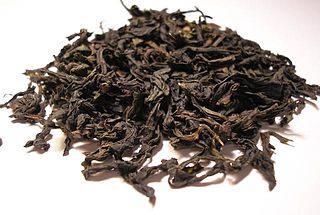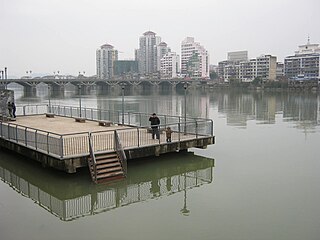
Oolong (, ; Chinese: 烏龍茶 is a traditional semi-oxidized Chinese tea produced through a process that includes withering the leaves under strong sun and allowing some oxidation to occur before curling and twisting. Most oolong teas, especially those of fine quality, involve unique tea plant cultivars that are exclusively used for particular varieties. The degree of oxidation, which is controlled by the length of time between picking and final drying, can range from 8% to 85% depending on the variety and production style. Oolong is especially popular in southeastern China and among ethnic Chinese in Southeast Asia, as is the Fujian preparation process known as the gongfu tea ceremony.

Fujian is a province on the southeastern coast of China. Fujian is bordered by Zhejiang to the north, Jiangxi to the west, Guangdong to the south, and the Taiwan Strait to the east. Its capital is Fuzhou and its largest city by population is Quanzhou, other notable cities include the port city of Xiamen and Zhangzhou. Fujian is located on the west coast of the Taiwan Strait as the closest geographically and culturally to Taiwan. Certain islands such as Kinmen are only approximately 10 km (6.2 mi) east of Xiamen in Fujian.

The Wuyi Mountains or Wuyishan are a mountain range located in the prefecture of Nanping, in northern Fujian province near the border with Jiangxi province, China. The highest peak in the area is Mount Huanggang at 2,158 metres (7,080 ft) on the border of Fujian and Jiangxi, making it the highest point of both provinces; the lowest altitudes are around 200 metres (660 ft). Many oolong and black teas are produced in the Wuyi Mountains, including Da Hong Pao and lapsang souchong, and are sold as Wuyi tea. The mountain range is known worldwide for its status as a refugium for several rare and endemic plant species, its dramatic river valleys, and the abundance of important temples and archeological sites in the region, and is a UNESCO World Heritage Site.

Sanming, also known as Minzhong, is a prefecture-level city in western Fujian province, China. It borders Nanping City to the north, Fuzhou City to the east, Quanzhou City to the southeast, Longyan City to the south and the province of Jiangxi to the west. Sanming lies between Wuyi and Daiyun mountains.

Nanping is a third-tier prefecture-level city in northwestern Fujian Province, People's Republic of China. It borders Ningde to the east, Sanming to the south, and the provinces of Zhejiang and Jiangxi to the north and west respectively. Part of the famous Bú-î Mountains range is located in this prefecture. Its population was 2,680,645 as of the 2020 census whom 795,448 lived in the built-up area made up of Yanping and Jianyang urban districts.

Rana is a genus of frogs commonly known as the Holarctic true frogs, pond frogs or brown frogs. Members of this genus are found through much of Eurasia and western North America. Many other genera were formerly included here. These true frogs are usually largish species characterized by their slim waists and wrinkled skin; many have thin ridges running along their backs, but they generally lack "warts" as in typical toads. They are excellent jumpers due to their long, slender legs. The typical webbing found on their hind feet allows for easy movement through water. Coloration is mostly greens and browns above, with darker and yellowish spots.

Shui Xian is a cultivar of Camellia sinensis as well as an oolong tea traditionally from the Wuyi Mountains in Fujian, China. The infused color is a deep amber which is characteristic for many other Wuyi oolong teas. This tea is also grown in Taiwan.

Tieluohan or Tie Luo Han is one of the Four Great Oolongs and a light Wuyi tea. Tieluohan is the cultivar responsible for one of the four best known Yán chá, "rock teas" grown on cliffs in the Wuyi Mountains in northern Fujian Province, China. Legend tells that this tea was created by a powerful warrior monk with golden-bronze skin, hence the name Tieluohan, which means "Iron Arhat" or "Iron Warrior Monk".

Wuyi tea, also known by the trade name Bohea in English, is a category of black and oolong teas grown in the Wuyi Mountains of northern Fujian, China. The Wuyi region produces a number of well-known teas, including Lapsang souchong and Da Hong Pao. It has historically been one of the major centers of tea production in Fujian province and globally. Both black tea and oolong tea were likely invented in the Wuyi region, which continues to produce both styles today.

Amolops is a genus of true frogs native mainly to eastern and south-eastern Asia. These frogs are closely related to such genera as Huia, Meristogenys, Odorrana, Pelophylax and Rana, but still form a distinct lineage among the core radiation of true frogs. They are commonly known as "torrent frogs" after their favorite habitat - small rapid-flowing mountain and hill streams - but this name is used for many similar-looking frogs regardless of whether they are loosely related.

Shaowu is a county-level city in northwestern Fujian province, People's Republic of China, located in the central part of the Wuyi Mountains and bordering Jiangxi province to the west. It has more than 100,000 inhabitants. The local dialect combines elements from Northern Min and Gan Chinese.

Amolops wuyiensis, commonly known as the Wuyi torrent frog, is a species of frog in the family Ranidae that is endemic to south-eastern China where it is found in Fujian, Anhui and Zhejiang provinces. Its name refers to the Wuyi Mountains in Fujian.

Wuyishan City is a county-level city in the municipal region of Nanping, in the northwest of Fujian, People's Republic of China, which borders Jiangxi to the northwest. It corresponds to the former Chong'an County.

Pucheng County is a county under the jurisdiction of the municipality of Nanping, in northern Fujian province, People's Republic of China, bordering Jiangxi to the northwest and Zhejiang to the east; it is the northernmost county-level division of Fujian.
Qianxisaurus is an extinct genus of pachypleurosaur or alternatively a basal eosauropterygian known from the Middle Triassic of Guizhou Province, southwestern China. It contains a single species, Qianxisaurus chajiangensis.

Jinjunmei (金駿眉) is a celebrated black tea from the Wuyi Mountains in Fujian Province, China. It is made exclusively from the buds plucked in early spring from the tea plant. The buds are subsequently fully oxidized and then roasted to yield a tea that has a sweet, fruity and flowery flavour with a long-lasting sweet after-taste. The brew is bright reddish in colour. It is a representative of high-end black tea in Fujian and has now become one of the most expensive varieties of black tea in China.

Dong Ding, also spelled Tung-ting, is an oolong tea from Taiwan. A translation of Dong Ding is "Frozen Summit" or "Icy Peak", and is the name of the mountain in Taiwan where the tea is cultivated. Those plants were brought to Taiwan from the Wuyi Mountains in China's Fujian Province about 150 years ago.

Rana dabieshanensis is a species of true frog that was discovered in the Dabie Mountains in Anhui, China through genetic analysis and morphology.
















